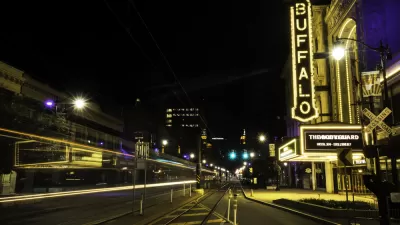Coney Island fights to preserve its history of sideshows and tilt-a-whirls as revitalization steps into the ring.
"For the past 25 years, Dick Zigun, the founder and artistic director of Coney Island USA, an arts organization, has found a way to capitalize on (...) the area's overlay of dissolution and current decay, and to elevate it to an aesthetic defining the area's art and entertainment. Back in the early '80s, Mr. Zigun created the Coney Island Circus Sideshow (complete with fire-eaters and contortionists) and launched the annual Mermaid Parade, both events that are hipster must-sees as well as good old-fashioned entertainment for the irony-free.
Mr. Zigun, a major figure in the revitalization of the area and a frequent informal spokesman for the amusement industry's various proprietors, was willing to see Coney Island's particular grittiness, cherished by some, obliterated in the name of a major redevelopment plan announced by the city in 2003.
"People find the seediness charming, and I realized that in terms of the way capitalism works and real estate works, you can't become enamored of the seediness," he said. "That's not what Coney Island was in its heyday."
Mr. Zigun was invoking the Coney Island of the early 20th century, when the amusement park sprawled across 70 acres, drawing both high-end and mass clientele to its spectacular state-of-the-art-rides and restaurants, its standing-room-only beach.
The possibilities of the city's strategic plan for Coney Island seduced Mr. Zigun, who signed on and joined the board of the Coney Island Development Corporation. For the future he saw grandeur, spectacle, phantasms. He saw, specifically, 15 acres of open-air amusement park, a significant expansion over the current space, and, in that acreage, the possibility for the world's greatest urban amusement park.
Last April, the city reduced the area dedicated to an open-air amusement park to nine acres. Last week, frustrated with the plan and its trajectory, Mr. Zigun resigned from the board."
FULL STORY: Visions for Coney Island Differ: Breathtaking Rides, or Shopping?

Trump Administration Could Effectively End Housing Voucher Program
Federal officials are eyeing major cuts to the Section 8 program that helps millions of low-income households pay rent.

Planetizen Federal Action Tracker
A weekly monitor of how Trump’s orders and actions are impacting planners and planning in America.

Ken Jennings Launches Transit Web Series
The Jeopardy champ wants you to ride public transit.

Rebuilding Smarter: How LA County Is Guiding Fire-Ravaged Communities Toward Resilience
Los Angeles County is leading a coordinated effort to help fire-impacted communities rebuild with resilience by providing recovery resources, promoting fire-wise design, and aligning reconstruction with broader sustainability and climate goals.

When Borders Blur: Regional Collaboration in Action
As regional challenges outgrow city boundaries, “When Borders Blur” explores how cross-jurisdictional collaboration can drive smarter, more resilient urban planning, sharing real-world lessons from thriving partnerships across North America.

Philadelphia Is Expanding its Network of Roundabouts
Roundabouts are widely shown to decrease traffic speed, reduce congestion, and improve efficiency.
Urban Design for Planners 1: Software Tools
This six-course series explores essential urban design concepts using open source software and equips planners with the tools they need to participate fully in the urban design process.
Planning for Universal Design
Learn the tools for implementing Universal Design in planning regulations.
Ada County Highway District
Clanton & Associates, Inc.
Jessamine County Fiscal Court
Institute for Housing and Urban Development Studies (IHS)
City of Grandview
Harvard GSD Executive Education
Toledo-Lucas County Plan Commissions
Salt Lake City
NYU Wagner Graduate School of Public Service





























